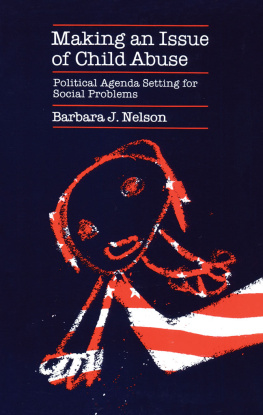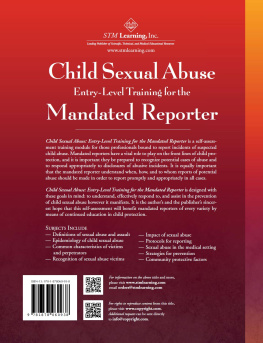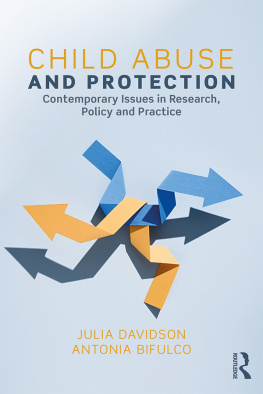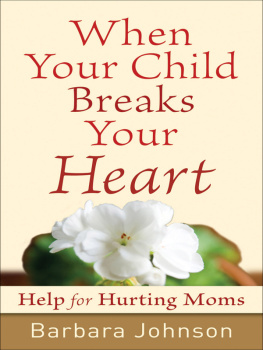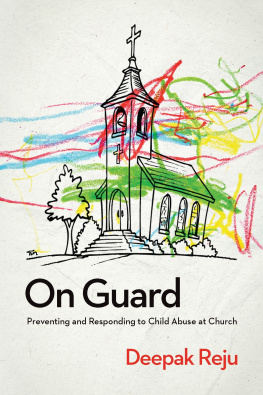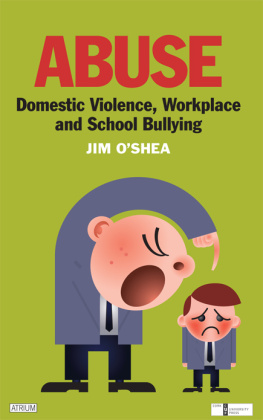The University of Chicago Press, Chicago 60637
The University of Chicago Press, Ltd., London
1984 by the University of Chicago
All rights reserved. Published 1984
Paperback edition 1986
Printed in the United States of America
06 05 04 03 02 01 00 7 8 9 10
ISBN 978-0-226-22001-7 (ebook)
LIBRARY OF CONGRESS CATALOGING IN PUBLICATION DATA
Nelson, Barbara J., 1949
Making an issue of child abuse.
Includes bibliographical references and index.
1. Child abuseGovernment policyUnited States. I. Title.
HV741.N39 1984 362.7'044 83-18044
ISBN 0-226-57201-3 (paper)

The paper used in this publication meets the minimum requirements of the American National Standard for Information SciencesPermanence of Paper for Printed Library Materials, ANSI Z39.481984.
Preface
I remember quite vividly when I first became interested in how the problem of child abuse became a public policy issue. In 1974, as a Mershon Public Policy Intern at the Ohio State University, I worked on a project investigating how hospitals respond to child abuse cases. My task was to write a questionnaire which would elucidate how and when hospitals determine that a child has been maltreated. I had a fair amount of experience writing questionnaires but knew nothing about child abuse. It seemed sensible to go straight to the reference room to remedy this lack.
There I was confronted by a startling finding. An examination of the Readers Guide to Periodical Literature and the Social Science and Humanities Index showed that absolutely no articles on child abuse (regardless of what term one used) had been published before 1962. Later research in other indexes proved me slightly wrong, but at that moment I was surprised and intrigued by the finding. Certainly some parents had always treated their children brutally. Why hadnt anyone written about it before 1962? What happened in 1962 to make abuse newsworthy? What transformed a condition into a social problem, and a social problem into a policy issue?
These questions piqued my interest so thoroughly that I decided to do research on agenda setting. The question became, Which issue or issues should I choose? The more I read about child abuse, the more I was convinced that doing a series of case studies on abuse would answer many of my more general questions about policy initiation. Child abuse had achieved several governmental agendas over a twenty-year period. The problem first came to the attention of public officials in 1955, when the American Humane Association shared its new research on abuse with the U.S. Childrens Bureau. The Bureaus concern, aided by media attention, spurred state legislatures to pass child abuse reporting laws, and congressional interest soon followed. Here was a good example of intergovernmental influences on agenda setting, a subject all but absent from the agenda-setting literature.
The child abuse case added to the work on agenda setting in other ways as well. Much of the previous research had examined how technological change encouraged government to adopt new issues. Child abuse, on the other hand, was not a new problem, merely a newly recognized one. Moreover, child abuse was emblematic of a great deal of social policy making in America. In a country with no popularly successful socialist tradition and little public support for redistribution, there seemed to be a need for research on smaller, categorical programs where group demands for special social intervention are met. In addition, this issue allowed me to investigate how the state constructs and maintains the boundary between the public and private spheres through the manipulation of widely cherished symbols. Altogether, child abuse was a very compelling issue on which to base my study.
I brought my interests in agenda setting and child abuse to Princeton. With the support of the Daniel and Florence Guggenheim Research Program in Criminal Justice, directed by Jameson Doig, I was able to begin my research. My objective was to discover and reconstruct how individuals became concerned about the problem and how they mobilized their institutions to respond. The process of discovery and reconstruction was both exhilarating and exhausting. In trips to Denver, Chicago, New York, Boston, and Washington, D.C., the written records were located. These records took many formsunpublished memos, correspondence, and reports, as well as books and journal articles. As always, the search was full of adventures. In the middle of research, one hard-pressed agency was contemplating destroying all but its most current records, and another discovered its historical records filed in a long-forgotten storeroom!
In addition, I interviewed fifty-two people who participated in setting the agendas under study. The interviews, which lasted from thirty minutes to twelve hours (over several days), were conducted with past and present high-ranking officials in the executive branch, members of Congress, congressional staff members, noted researchers, professors, legal and medical practitioners in the child abuse field, and national leaders in relevant private charity groups. The interviews focused on individuals who participated in setting the public agenda, sometimes to the exclusion of people who established or ran interesting programs. In addition, I interviewed a number of people whom I felt could or should have participated in setting particular agendas. This strategy paid handsome dividends in expanding my understanding of the structural barriers to access to public officials.
The interviews were semistructured and were conducted in three different ways. In most instances I conducted the interview, aided by an assistant who took detailed, often verbatim notes. On a few occasions, I conducted the interviews alone, and on fewer still, the interviews were taped and transcribed. The decision on which method to use was made on purely pragmatic grounds. Most people felt more at ease and were probably more candid when not confronted by a tape recorder. With very few exceptions (two to be exact), the individuals interviewed were open, helpful, and blessedly generous.
A word is in order on the use of quotations in this book. In his book, A Government of Strangers, Hugh Heclo posited a wonderful rule about quoting informantsno speakers were ever identified even when they wanted to be. That rule, appealing for its protection of the participants but perhaps disturbing to some readers, has not been used. Instead a more difficult rule has been substituted. All quotations remain anonymous unless there is public, documentary evidence which substantially says the same thing. This rule was chosen to create a balance between the protection of participants and the need for historical detail.
The carefully crafted words of three people sustained me while I wrote this book, and this triumvirateunlikely though it isdeserves special mention. For encouragement in the labor of writing, I would like to acknowledge Anatole Broyard, Jimmy Breslin, and the late Anne Sexton.
Barbara J. Nelson
 The paper used in this publication meets the minimum requirements of the American National Standard for Information SciencesPermanence of Paper for Printed Library Materials, ANSI Z39.481984.
The paper used in this publication meets the minimum requirements of the American National Standard for Information SciencesPermanence of Paper for Printed Library Materials, ANSI Z39.481984.
